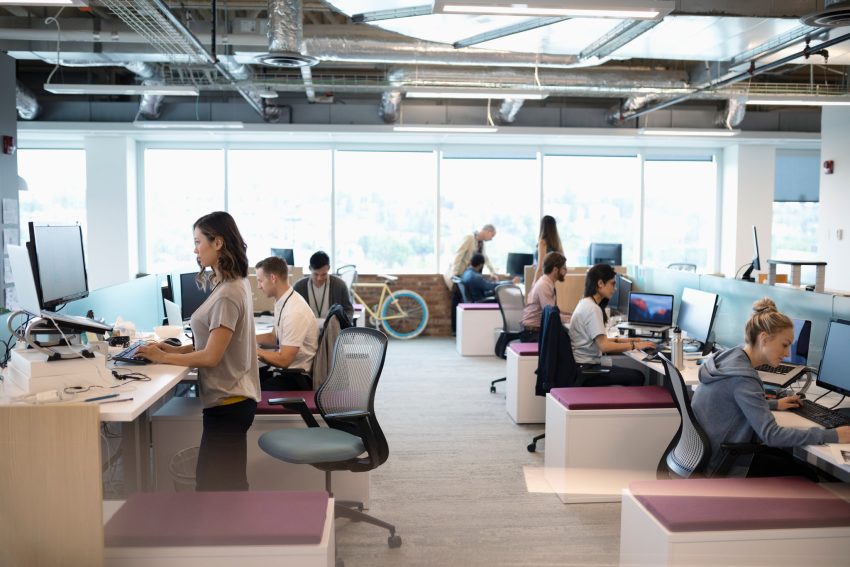The Sedentary Workplace Paradox
Recent studies suggest that workplaces with more open spaces and those that promote movement between them can improve the physical and mental well-being of employees.
The paradox of physical activity in the workplace refers to the contradiction between the need for a person to stay active to preserve health and the design of many work environments that encourage sedentary behavior. According to a study published in the Journal of Occupational Health (2021), people who work in an office spend an average of 75% of their workday sitting, which is associated with an increased risk of cardiovascular disease, diabetes, and obesity.
This paradox highlights the urgent need to redesign workspaces, as they play a crucial role in promoting or restricting the physical activity of company personnel. Redesigning offices can eliminate exposure to a significant health risk for workers: sedentary behavior, which is one of the leading causes of death globally.
Redesigning the Office for Health
Traditional office spaces, with fixed desks and comfortable office chairs, encourage sedentary behavior that can have negative health consequences. In contrast, an office design that promotes more open spaces and mobility between them can significantly improve the physical and mental well-being of the workforce.
One of the most effective strategies is the incorporation of adjustable desks, which allow for alternating between sitting and standing positions. This flexibility has been shown to reduce total sedentary time and improve posture, which is beneficial for cardiovascular and muscular health. Additionally, the arrangement of furniture can influence activity levels. For example, placing printers and other shared equipment far from work desks promotes breaks that break up prolonged sedentary behavior.
The use of stairs, instead of elevators, can also be promoted through architectural design. Attractive and accessible stairs, accompanied by motivational signs, can increase their regular use. Active rest areas, equipped with treadmills, stationary bikes, or space for stretching and light exercise, also encourage physical activity during work breaks. Moreover, outdoor spaces such as gardens or patios can be designed to encourage walking during breaks.
Practical Guidelines for Workplace Activity
Despite the health risk associated with limited movement in office jobs, there are no specific physical activity prescription guidelines for workplaces. However, a recently published article in the British Journal of Sports Medicine presents a practical guide for physical activity in the workplace, based on the FITT formula, which considers the Frequency, Intensity, Time or duration, and Type of activity.
For frequency, it is recommended to focus on safe movements, avoiding long periods of sedentary behavior, and alternating sitting time with movement breaks or physical activity in free time of 15 to 30 minutes. In terms of intensity, it is essential to perform safe and reasonable activities with common sense, avoid prolonged static tension and sustained high-intensity efforts, and promote moderate to vigorous intensity activities in free time. For time or duration, it is advisable to avoid prolonged periods of sedentary behavior and encourage physical activity in general, especially during free time. Finally, regarding the type of activity, exercises such as walking, yoga, and other modalities that promote safe movement are suggested, as well as recovery activities such as stretching or mindfulness breaks. It is also recommended to ask oneself if they feel comfortable and safe with the activity, and thus avoid high-risk activities that could cause some type of injury.
Beyond Design: Organizational Culture and Behavior
It is clear, therefore, that the design of the workplace and the behavior of the team of workers is key to promoting physical activity in this environment. However, we should not ignore other very important aspects. We refer, among others, to the impact of organizational culture, company norms and policies, incentive and reward strategies, psychosocial barriers and facilitators. Let’s take the example of how the dress code expected of workers can facilitate or hinder movement in the office. Another example is the dynamics of meetings; if there is a tradition of holding them seated in a meeting room, making them more informal standing up, or even discussing work topics by taking a short walk outside the office.
Conclusion: A Call for More Research
In conclusion, the paradox of physical activity highlights the crucial need for specific guidelines for different contexts; and based on scientific evidence, but today there are still many gaps. While these research gaps are being closed, the practical recommendations based on current knowledge—which we have already mentioned—should serve as a guide for employees and employers, as they can be great allies in public health. Clarifying how to address this paradox is an essential step to protect the health and well-being of workers.

